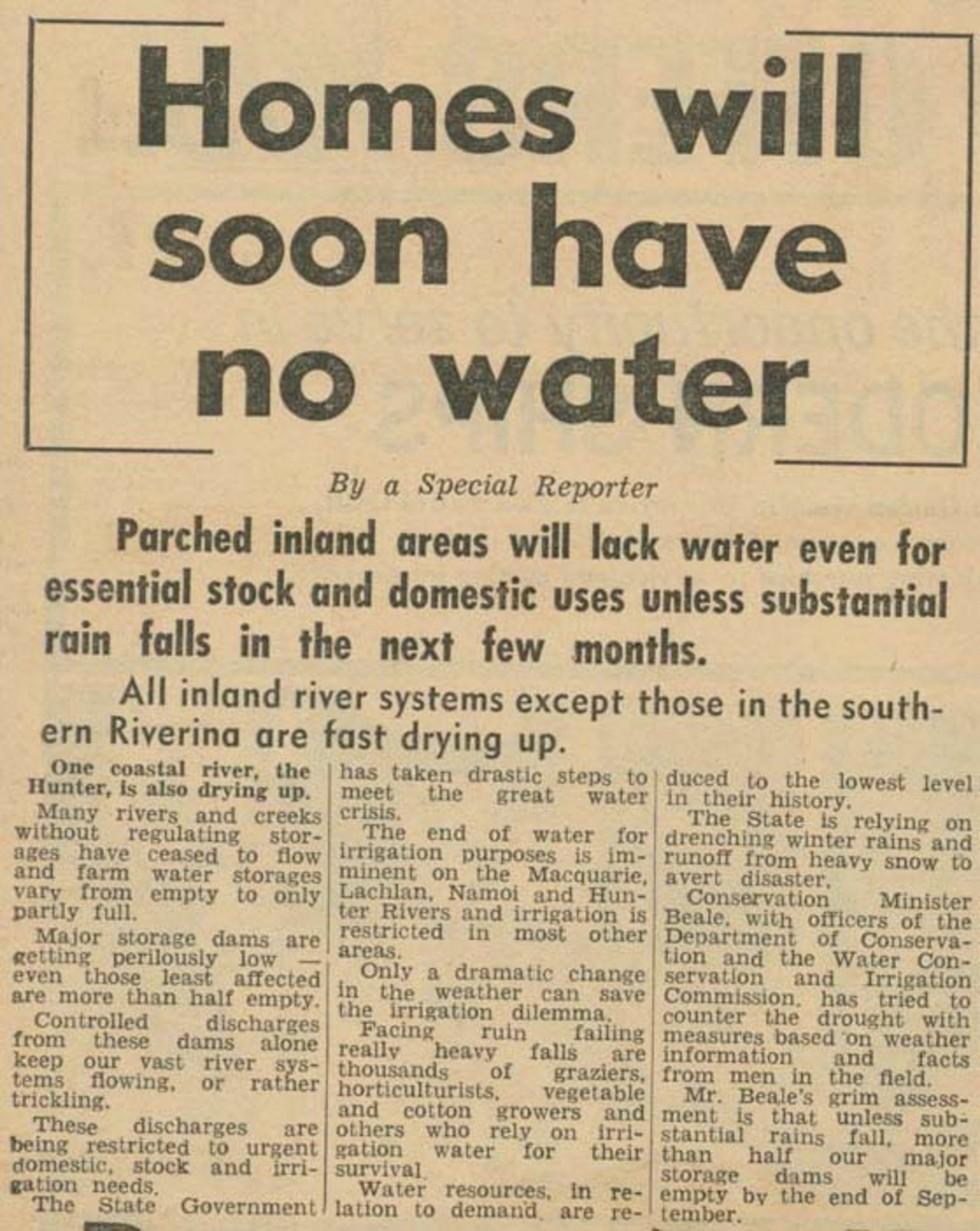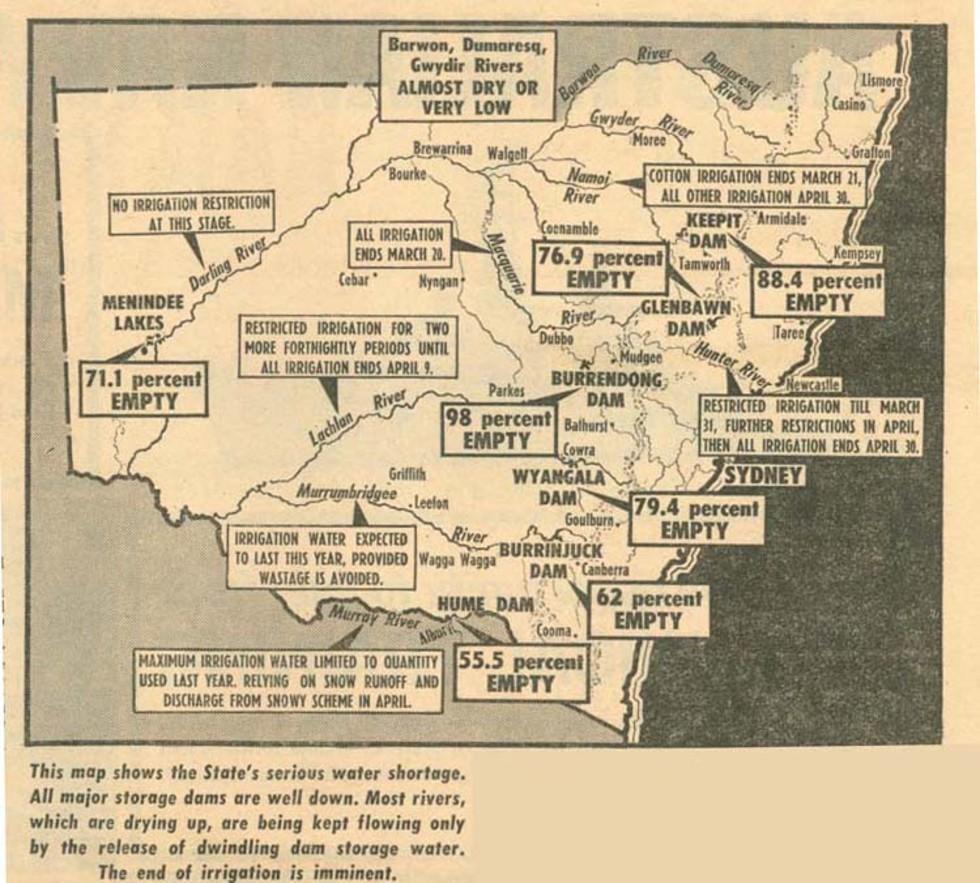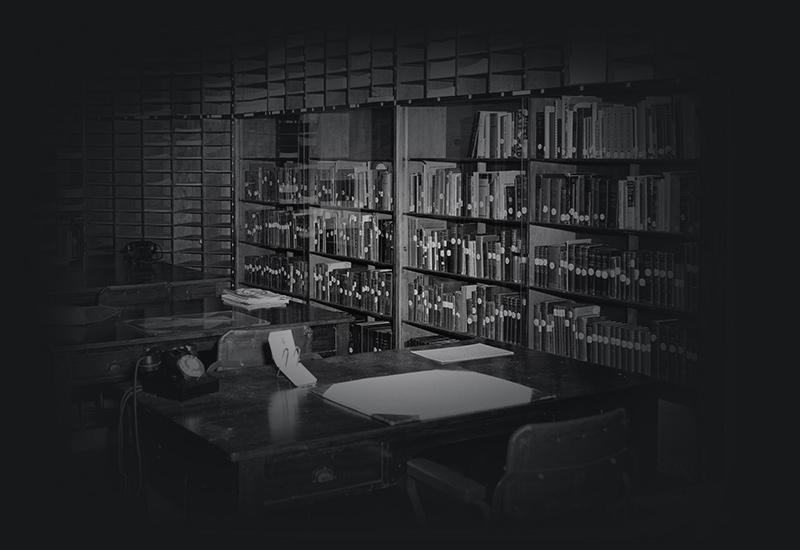

Aboriginal and Torres Strait Islander people should be aware that the National Archives' website and collection contain the names, images and voices of people who have died.
Some records include terms and views that are not appropriate today. They reflect the period in which they were created and are not the views of the National Archives.



[Page 1.]
[Newspaper article.]
[Large title reads:] Homes will soon have no water.
[Italicised] By a Special Reporter.
[Bold} Parched inland areas will lack water even for essential stock and domestic uses unless substantial rain falls in the next few months.
All inland ricer systems except those in the southern Riverina are fast drying up.
One coastal river, the Hunter, is also drying up. Many rivers and creeks without regulating storages have ceased to flow and farm water storages vary from empty to only partly full.
Major storage dams are getting perilously low – even those least affected are more than half empty.
Controlled discharges from these dams alone keep our vast river systems flowing, or rather trickling.
These discharges are being restricted to urgent domestic, stock and irrigation needs.
The State Government has taken drastic steps to meet the great water crisis.
The end of water for irrigation purposes is imminent on the Macquarie, Lachlan, Namoi and Hunter Rivers and irrigation is restricted in most other areas.
Only a dramatic change in the weather can save the irrigation dilemma.
Facing ruin failing really heavy falls are thousands of graziers, horticulturalists, vegetable and cotton growers and other who rely on water for their survival.
Water resources, in relation to demand are reduced to the lowest level in their history.
The State is relying on drenching winter rains and runoff from heavy snow to aver disaster.
Conservation Minister Beale, with officers of the Department of Conservation and the Water Conservation and Irrigation Commission has tried to counter the drought with measures based on weather information and facts from men in the field.
Mr. Beale's grim assessment is that unless substantial rains fall, more than half our major storage dams will be empty by the end of September.
[Page 2.]
[This page contains a greyscale diagram of the State of New South Wales. The major rivers and dams of the state have been labelled. Under the diagram is a caption that reads:] This map shows the State's serious water shortage. All major storage dams are well down. Most rivers, which are drying up, are being kept flowing only by the release of dwindling dam storage water. The end of irrigation is imminent.
[Listed below are the labels of the diagram reading from North to South and West to East.]
Barwon, Dumaresq, Gwydir Rivers[:] ALMOST DRY OR VERY LOW.
Namoi River[:] COTTON IRRIGATION ENDS MARCH 21, ALL OTHER IRRIGATION APRIL 30.
Darling River[:] NO IRRIGATION RESTRICTION AT THIS STAGE.
Macquarie River[:] ALL IRRIGATION ENDS MARCH 20.
KEEPIT DAM[:] 88.4 percent EMPTY.
GLENBAWN DAM[:] 76.9 percent EMPTY.
MENINDEE LAKES[:] 71.1 percent EMPTY.
Lachlan River[:[ RESTRICTED IRRIGATION FOR TWO MORE
FORTNIGHTLY PERIODS UNTIL ALL IRRIGATION ENDS APRIL 9.
BURRENDONG DAM[:] 98 percent EMPTY.
Hunter River[:] RESTRICTED IRRIGATION TILL MARCH 31, FURTHER RESTRICTIONS IN APRIL, THEN ALL IRRIGATION ENDS APRIL 30.
Murrumbidgee River[:] IRRIGATION WATER EXPECTED TO LAST THIS YEAR, PROVIDED WASTAGE IS AVOIDED.
WYANGALA DAM[:] 79.4 percent EMPTY.
BURRINJUCK DAM[:] 62 percent EMPTY.
Murray River[:] MAXIMUM IRRIGATION WATER LIMITED TO QUANTITY USED LAST YEAR. RELYING ON SNOW RUNOFF AND DISCHARGE FROM SNOWY SCHEME IN APRIL.
HUME DAM[:] 55.5 percent EMPTY.
Learn how to interpret primary sources, use our collection and more.
